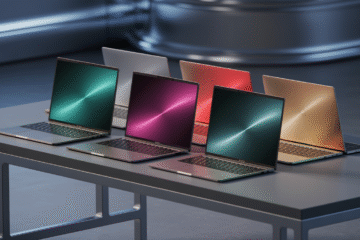Best Laptops for 3D Modeling & CAD (2025)
Choosing a laptop for 3D modeling and CAD isn’t the same as buying a general-purpose notebook. You’re balancing CPU clocks and cores (for parametric rebuilds, constraints, Boolean ops), GPU power (for shaded/real-time viewports and GPU renders), RAM capacity (for big assemblies and complex meshes), and storage speed (for gigantic project files, cache, and texture libraries). Add to that the need for a color-reliable display, thermals that don’t throttle mid-render, and ports for your devices and external monitors and it’s easy to see why some “fast” laptops still struggle with CAD workloads.
This guide lays out what actually matters for CAD and 3D, then ranks six options you asked for from 6 to 1 with clear advice on who should choose each and how to configure them to get the most performance per dollar.
What Really Matters for CAD & 3D
CPU: Frequency First, Then Cores
Most CAD kernels (SolidWorks, Inventor, Fusion 360’s parametric tools, Revit modeling, Rhino) love high single-core clocks. You’ll feel the difference when sketch constraints rebuild quickly and features recompute without lag. Multi-core helps for renders (KeyShot, Blender Cycles, Arnold), simulations (CFD/FEA), and background tasks. Aim for the newest Intel Core, AMD Ryzen, or Apple Silicon generation you can afford.
GPU: Viewport Smoothness & GPU Rendering
For shaded viewports, NVIDIA RTX (even laptop-class) provides stable performance and good driver support in most DCC apps. AMD and Apple GPUs are also strong; Apple Silicon’s GPU + media engines are excellent for creative suites and increasingly capable in DCC. If you rely on OptiX/CUDA GPU rendering, NVIDIA still has an advantage.
RAM: 16GB Minimum; 32GB Sweet Spot
Complex assemblies, high-poly sculpts, and large Revit/Fusion projects can chew through memory. 16GB is the floor; 32GB is ideal for comfort and multitasking (CAD + renderer + references).
Storage: NVMe SSD, 1TB Preferred
CAD libraries, textures, point clouds, and proxy caches balloon quickly. A 1TB NVMe SSD keeps loads and saves snappy; 512GB works if you’re disciplined and use external SSDs for archives.
Display: Size, Resolution, and Accuracy
Working on a 15–17″ display reduces panning/zoom fatigue; 16:10 aspect ratio shows more vertical lines in tool panels and sketches. Aim for 300+ nits and an IPS or better panel. If you do material/lighting work, consider an external, calibrated monitor.
Thermals, Noise & Power
Sustained loads expose weak cooling. A laptop that keeps boost clocks through a 30-minute render is worth more than one that spikes then throttles. Expect to work plugged in for best performance.
ISV Drivers & Stability
Independent Software Vendor (ISV)-tested graphics drivers matter for some CAD apps. Even without official certification, stick to current drivers and stable OS builds.
6: Lenovo IdeaPad 1 Laptop – Entry to CAD, Done Right
Who It’s For
Beginners learning Fusion 360, TinkerCAD, SketchUp, or Onshape, and students handling 2D drafting (AutoCAD LT) with small 3D parts. It’s also fine for parametric practice and basic rendering using CPU at modest quality.
Why It Works (Within Limits)
-
Modern U-series CPUs give decent single-core performance for light sketching/feature rebuilds.
-
NVMe SSDs keep the system responsive; choose 512GB if possible.
-
Lightweight and affordable—great as a first machine.
Configure It Smart
-
RAM: Push to 16GB if configurable; 8GB feels tight with CAD + browser + docs.
-
External Monitor: A 24–27″ 1440p monitor boosts usability and precision.
-
Expectations: Not for massive assemblies, high-poly sculpts, or GPU denoising—keep projects small and learn fundamentals.
5: Dell Latitude 5400 Laptop – Business Stability for CAD Basics
Who It’s For
Students and professionals who need business-class reliability, lots of ports, and office comfort, while working on light 3D models, 2D layouts, BIM coordination, and training projects.
Why It Works
-
Latitude keyboards and trackpads are excellent for long sessions.
-
I/O often includes USB-A, USB-C/Thunderbolt (varies), HDMI, and sometimes Ethernet—perfect for labs and offices.
-
Thermals are tuned for stability; it runs predictably during meetings and moderate modeling.
Configure It Smart
-
CPU: Choose the fastest current-gen CPU SKU available.
-
RAM: 16–32GB (32GB if you multitask with renderers).
-
Storage: 512GB–1TB NVMe.
-
GPU: Integrated/iGPU models are OK for drafting/viewport basics; don’t expect real-time ray tracing performance.
Use Case Reality
Great for AutoCAD, Revit viewing/markups, small Fusion assemblies, and Rhino concept modeling. For GPU-heavy work, consider external eGPU docks (where supported) or step up to a performance tier later.
4: Microsoft Surface Laptop – Premium Typing, Accurate Screen, Solid CAD Comfort
Who It’s For
Designers and architects who value a calibrated display, fantastic keyboard/trackpad, and a refined Windows experience for modeling + presentations. Excellent for SketchUp, Rhino, Fusion 360 (light to moderate), and Revit documentation.
Why It Works
-
High-quality panels with good color/brightness aid material previews and client reviews.
-
Modern CPU options keep single-core snappy for parametric work.
-
Portable and quiet—ideal for studio, classroom, and client meetings.
Configure It Smart
-
RAM: 16–32GB (choose 32GB if you keep Adobe apps and CAD open together).
-
Storage: 1TB for libraries and project caches.
-
Docking: A USB-C/Thunderbolt dock + external monitor creates a real desk setup.
Reality Check
This is not a “gaming GPU” powerhouse viewport performance is fine for conceptual modeling and medium complexity. For heavy real-time ray tracing or massive assemblies, jump to a workstation-class option.
3: Lenovo V15 G4 ABP Laptop – Value 15″ Canvas for Growing CAD Skills
Who It’s For
Learners who want a bigger 15″ workspace and a sensible budget to start Fusion 360 part design, AutoCAD detailing, and Rhino surface work with light rendering.
Why It Works
-
15″ display reduces tool/menu crowding and helps with precise snaps and constraints.
-
Value-oriented, often with upgradeable RAM/SSD (check your SKU).
-
Sturdy enough for daily campus/office travel.
Configure It Smart
-
CPU: Grab the newest generation available.
-
RAM: 16GB minimum; 32GB preferred if supported.
-
Storage: 1TB NVMe to hold project versions and textures.
-
Cooling: Use a laptop stand for airflow during long renders.
Use Case Reality
Excellent for education, freelance prototypes, and light commercial work. Keep assemblies moderate; rely on section views, Lod management, and proxy meshes to stay smooth.
2: Apple MacBook Pro Laptop – Creator-Grade Display, Strong CPU/GPU, Great Battery
Who It’s For
Architects, product designers, 3D artists, and engineers who want sustained CPU/GPU performance, a reference-class display (on XDR models), and industry-leading battery life for on-site work. Ideal for Blender, Maya (increasingly), Rhino for Mac, Vectorworks, Archicad, and Twinmotion/UE work via Apple’s modern GPU stack; also fantastic for Adobe and video pipelines.
Why It Works
-
Apple Silicon delivers top-tier single-core and excellent multi-core efficiency; timelines and viewports stay responsive on battery.
-
Media engines accelerate encodes for viz reels and presentations.
-
XDR displays (select models) provide exceptional brightness/contrast for material and light studies.
Configure It Smart
-
Memory: 32GB is a great baseline for 3D + Adobe; 64GB if you do heavy scenes or large BIM models.
-
Storage: 1–2TB internal + a fast Thunderbolt NVMe for assets.
-
External Monitor: Calibrated 27–32″ display for final reviews.
Caveats
If your pipeline is CUDA-specific (certain renderers/plugins), verify current support or plan for CPU/Metal alternatives. Many tools now run beautifully on Apple Silicon, but check your plugins and render choices.
1: HP 17 Touchscreen Laptop – Big-Screen Value for CAD Viewports & Drafting
Who It’s For
Beginners and cost-conscious pros who want a large 17″ canvas to see more of the model tree, constraints, and drawing sheets at once. Great for AutoCAD, Revit documentation, Fusion 360 part modeling, and Rhino concepting especially when you value screen size over ultra-portable form factors.
Why It Works
-
17″ display reduces zoom/pan fatigue; dual-pane layouts (model & drawing, or perspective & orthos) are more comfortable.
-
With smart configuration, it handles real-world CAD tasks smoothly and is pleasant for long sessions.
-
Touch can be handy for quick zoom/pan/orbit in reviews (you’ll still model with mouse/trackpad for precision).
Configure It Smart
-
CPU: Choose the fastest generation offered.
-
RAM: 32GB if possible (16GB minimum).
-
Storage: 1TB NVMe + external SSD for archives.
-
Cooling & Power: Use a stand for airflow; work plugged in for sustained clocks.
Reality Check
This is the best value in this lineup for a large, comfortable CAD workspace not a replacement for an RTX workstation if you do heavy GPU rendering. For assemblies of moderate complexity, it’s a productivity booster.
Windows vs macOS for CAD/3D (Quick Guidance)
-
Windows shines for broad CAD compatibility, legacy plugins, and the widest GPU choices (including CUDA/OptiX).
-
macOS (MacBook Pro) excels in battery-sipping performance, display quality, and increasingly robust DCC support (Blender Metal, pro creative suites). If your render stack is CUDA-locked, evaluate alternatives or cloud/render farms.
How to Configure Any CAD Laptop (Minimums & Nice-to-Haves)
Minimums (2025)
-
CPU: Latest-gen Intel/AMD or Apple Silicon, prioritize single-core clocks
-
RAM: 16GB (absolute floor)
-
Storage: 512GB NVMe (prefer 1TB)
-
Display: 15″+, IPS, ~300 nits, anti-glare
-
Ports: USB-C (PD), USB-A, HDMI/DP for external displays
Recommended (Comfortable)
-
CPU: Higher-bin part for better boost under sustained loads
-
RAM: 32GB
-
Storage: 1TB NVMe + external SSD
-
Display: 16–17″, 16:10, calibrated; external 27″+ monitor for desk work
-
Thermals: Cooling stand; keep vents clear; use high-performance mode when plugged in
Workflow Tips to Make Mid-Range Laptops Feel Pro
Model Clean, Manage Complexity
-
Use layers/components and Lod to hide heavy sub-assemblies.
-
Keep fillets/chamfers and high-poly details as late features; suppress during early work.
-
Leverage section boxes and worksets (BIM) to stay responsive.
Viewport Optimization
-
Reduce real-time AA/shadows while modeling; enable quality for reviews.
-
Use shaded or X-ray modes for sketching/constraining; switch to realistic only when needed.
Rendering Strategy
-
Prefer denoise + lower samples for previews; reserve high samples for final frames.
-
Consider cloud rendering or render farms for big animations.
Backups & Versioning
-
Use incremental saves and cloud sync (OneDrive/Google Drive/iCloud).
-
Keep project caches and textures on a fast external NVMe to move between machines.
Frequently Asked Questions
Is integrated graphics enough for CAD?
For 2D drafting and light 3D with small assemblies yes. For complex viewports, real-time ray tracing, or GPU rendering, you’ll want discrete NVIDIA/AMD or a MacBook Pro with higher-end GPU.
Do I really need 32GB RAM?
If you work with BIM models, complex assemblies, or keep CAD + renderer + Adobe apps open, 32GB prevents paging and stutter. For learning and small projects, 16GB is okay.
15″ vs 17″ for CAD?
17″ is fantastic for seeing more at once; 15–16″ is easier to carry. Many pros use a 27″ external at the desk either way.
Can a MacBook Pro replace a Windows CAD laptop?
Depends on your tools. For Blender/Rhino/Vectorworks/Archicad and creative suites, yes often with better battery and display. If your stack is CUDA-only or depends on niche Windows plugins, stay on Windows or use render/cloud workarounds.
Final Verdict
-
Best Value Big Canvas: HP 17 Touchscreen Laptop – generous screen real estate, comfortable daily CAD, and solid value when configured with 32GB/1TB.
-
Best macOS Option for CAD + Creative: Apple MacBook Pro Laptop – superb display, sustained performance, and mobile endurance; verify your render pipeline.
-
Best Budget 15″ for Learners: Lenovo V15 G4 ABP Laptop – roomy viewport and upgrade path; perfect for building skills.
-
Best Premium Windows Experience: Microsoft Surface Laptop – calibrated display and top-tier typing for design-forward workflows.
-
Best Business-Durable Starter: Dell Latitude 5400 Laptop – ports, reliability, and stability for school and office labs.
-
Best Entry on a Tight Budget: Lenovo IdeaPad 1 Laptop – great for fundamentals, 2D, and small 3D parts as you learn.
Whichever route you take, prioritize single-core speed, 32GB RAM (when possible), a 1TB NVMe, and a large, anti-glare display or external monitor. Combine that with clean modeling practices and viewport optimizations, and even mid-range hardware can carry surprisingly serious CAD and 3D work from concept to deliverable.



0 Comments